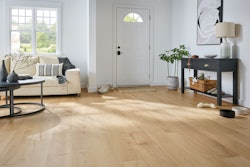
Solid and engineered wood flooring have significantly lower greenhouse gas emissions compared with alternative flooring options, according to a joint study by the Decorative Hardwoods Association and National Wood Flooring Association.
The study, independently verified by the ASTM, found builders and architects can reduce total greenhouse gas emissions by 82% by using engineered wood flooring over the alternatives.
Solid wood flooring had the lowest global warming potential totals of the floor coverings examined, with 9.2 kg CO2e. Engineered wood flooring’s global warming potential totals 11.41 kg CO2e. Rigid-core LVP had the highest cradle-to-grave global warming potential with 64.3 kg CO2e. Rubber was the second highest at 44.2 kg, followed by a number of vinyl flooring products, including vinyl tile LVT and SVT (41.8 kg), homogenous vinyl (29.2 kg), composition tile (26.9 kg), heterogeneous vinyl (26.1 kg) and ceramic tile (19.6 kg).
The full study can be found here.






















